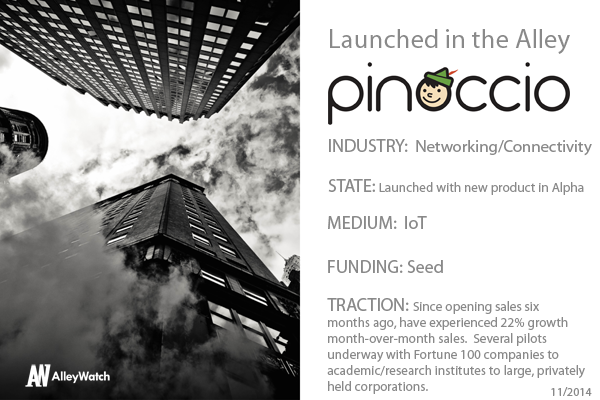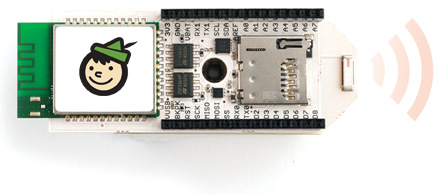Pinoccio is your own personal DIY IoT controller that allows you to build wireless, web-enabled projects in minutes, that are mesh networked, open source and Arduino compatible, so you can use the huge collection of Arduino libraries.
Pinoccio is also easy to program, affordable, and includes a rechargeable battery and a built-in radio that allows one Pinoccio with a WiFi shield to communicate wirelessly with other Pinoccios.
Now you’re talking!
Cofounder and CEO Eric Jennings tells us more about his experiences with the R/GA Accelerator, powered by Techstars, and his Grand Vision to create a decentralized Internet of Things.
Tell us about the decision to apply for R/GA Accelerator and how has the experience been thus far?
We’ve spent the last 18 months building out our product, platform, and team, and began selling our product publicly several months ago. More recently, we experienced a significant interest from industrial customers, but we didn’t have a lot of experience in navigating this space, from a business perspective. R/GA is world-class in building an ecosystem of products and services around complex connected devices, so it seemed like a perfect partner for the next phase of our company.
Tell us about your product.
Pinoccio makes industrial machines smarter, by connecting them to each other and to the web. Within minutes of unboxing, sensor data is streaming from device to web. Soon, machines from different vendors will talk directly to each other in a completely decentralized method, via our network stack.
Underlying this capability is our network stack, Telehash, an encrypted, peer-to-peer network protocol that allows any device to talk to any other device, completely independent of a server. Our grand vision is to establish a decentralized Internet of Things. Entire new business models will be built upon the future of independently-connected devices, and Pinoccio will help facilitate this new future.
How is it different?
Unlike typical wireless devices, our devices create their own wireless networks anywhere in the world–regardless of access to WiFi or cellular data service. This offers key functionality in areas such as agriculture, mining, oil and gas, manufacturing, and logistics, that just can’t be done with WiFi, LTE, or Bluetooth technologies. Of course, if Internet connectivity is available, it will be used–but it’s never required–unlike most of our counterparts in this space.
What market are you attacking and how big is it?
Our first product is focused specifically on environmental sensing within indoor industrial spaces. This includes manufacturing plants, data centers, and commercial building controls. BCC research estimates that the global environmental sensor and monitoring business will grow from $13.2 billion in 2014 to nearly $17.6 billion in 2019.
What is the business model?
Today we sell hardware at profit, and offer a software-as-a-service component for those customers who need bulletproof cloud capability, handling millions of devices in a secure, scalable manner. We have ambitious plans to grow into new business models as they mature over the next 1-2 years, but aren’t ready to discuss them publicly quite yet.
Tell us about the security associated with mesh networks in comparison to WiFi?
Security, to be done properly, must be included as a first-class concept from the very beginning of a product’s lifecycle. WiFi has reasonable security, as does most mesh networks (including Pinoccio.) However with Telehash–our networking stack–we have extremely capable, 100% end-to-end required encryption at all times. It’s designed to complement existing transport security on WiFi, Bluetooth 4/LE, and mesh networks. Each endpoint also has a verifiable, unique fingerprint. Just as importantly, it has very strict privacy: no content, identity, or metadata is ever revealed to third parties.
Telehash can run on top of more than just mesh networking. We see it as a fundamental requirement for any device-to-device communication, regardless of radio technology.
What are the milestones that you plan to achieve within six months?
We have several pilots underway with Fortune 100 companies to academic/research institutes to large, privately held corporations. We will have three of these pilots completed by Q1 2015, with a pipeline of another 25 companies three months after that.
If you could be put in touch with one investor in the New York community who would it be and why?
We¹ve always wanted to meet Beth Comstock as she¹s changing the landscape of IoT. The work that GE has been doing to change the state of the Industrial Internet aligns very well with our views of the connected future. Most importantly, GE are working to make that future a reality today, instead of just forming consortiums and bloviating about empty promises.
We recently met Alex Tepper from GE Ventures, which was very enlightening as well. He saw the value in our product’s ease-of-use from unboxing to streaming data to the web in minutes. This contrasts strongly with what we’re told most enterprise companies experience today–dumping their sensor data into spreadsheets and manually review them by eye.
What is your take on the current scene in New York today?
New York has always been an extremely diverse environment, culturally, politically, and socially speaking. This diversity is key to the technology industry here as well. I’m a big advocate of the tenets of Systems Theory and Permaculture. Both of these disciplines speak to the value of boundaries–of the value of connections between autonomous agents, rather than the value of the agents themselves. New York offers boundless connections between agents, from individuals to ideas to companies to mentors to capital. In my opinion, this is New York’s greatest contribution to the future of the human race.
What are you looking forward to doing most in NYC during this upcoming winter?
It’s funny, because the accelerator keeps us so busy and focused on building the company, that time starts to accelerate and it’s possible to miss out on what NYC has to offer, if you’re not careful. I do enjoy the food here so much, that I’m taking full advantage of the excellent restaurants every chance I get. Strangely, I stumble across the most interesting shops when walking around the city. Recently I came across a store called Control that sells amazing analog synthesizers. I ended up spending almost an hour in there making otherworldly sci-fi sounds. There really is something for everyone here.




